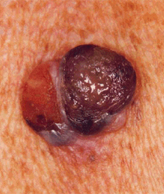Second Primary Melanoma Risk High Among Melanoma Survivors
In a recent study, survivors of either an invasive or in situ melanoma had about five times the risk for a second primary melanoma compared with the general population.
Melanoma survivors are at high risk for a second primary melanoma

People who have had either an invasive or in situ melanoma have about five times the risk for a second primary melanoma compared with the general population, according to a retrospective cohort study published recently in JAMA: Dermatology.
Risks identified by the study persisted for 10 years or more.
“We already know that survivors of an invasive melanoma have an increased risk of developing subsequent primary melanomas compared to the general population, and that there is some correlation by body site,” said study author Danny R. Youlden, BSc, of Cancer Council Queensland, Brisbane, Queensland, Australia. “This large, population-based study adds to the existing literature by quantifying the relative risks of being diagnosed with a subsequent primary invasive melanoma by body site following either a first primary invasive or in situ melanoma.”
Youlden and colleagues collected population-based administrative data for all melanoma diagnoses that were included in the Queensland Cancer Registry between 1982 and 2005 and reviewed data to Dec. 31, 2010. The registry included 39,668 cases of first primary melanoma and 22,845 cases of first primary in situ melanoma. The researchers calculated standardized incidence ratios (SIRs) by dividing the observed number of subsequent primary invasive melanomas by the product of the strata-specific incidence rates that occurred in the general population and the cumulative time at risk for the cohort.
“We found that all people who have been previously diagnosed with melanoma, whether it be invasive or in situ, had a significantly increased relative risk of a subsequent primary invasive melanoma,” Youlden said.
The study identified 5,358 subsequent primary invasive melanomas. This translated into a SIR of 5.42 (95% CI, 5.23-5.61) for first primary invasive melanoma and an SIR of 4.59 (95% CI, 4.37-4.82) for first primary in situ melanoma.
“The fact that the relative risk was almost as high following an in situ melanoma compared to an invasive melanoma was a bit unexpected,” Youlden said. “Previously in-situ melanomas had been thought of as almost incidental, the result of ‘overdiagnosis,’ but our data demonstrate that they are an important indicator of increased melanoma risk.”
The researchers also found that the greatest relative risk tended to occur on the same part of the body as the original lesion, particularly when the first melanoma was on the head. Specifically, the largest relative risk was identified in women with a first primary melanoma on the head followed by a subsequent primary melanoma on the head (SIR = 13.32; 95% CI, 10.28-16.98).
However, the relative risk remained elevated irrespective of body site, sex, age at first diagnosis, and time between diagnoses.
“Ongoing surveillance is required, giving particular attention to the body site of the initial melanoma,” Youlden said. “Our results strongly suggest that existing clinical practice guidelines regarding education and follow-up for patients with invasive melanoma should be extended to include those diagnosed with an in situ melanoma.”
Newsletter
Stay up to date on recent advances in the multidisciplinary approach to cancer.